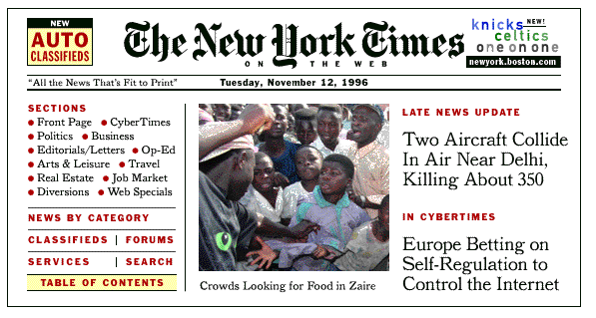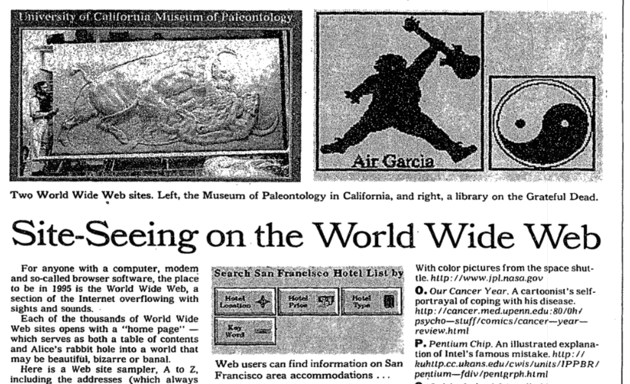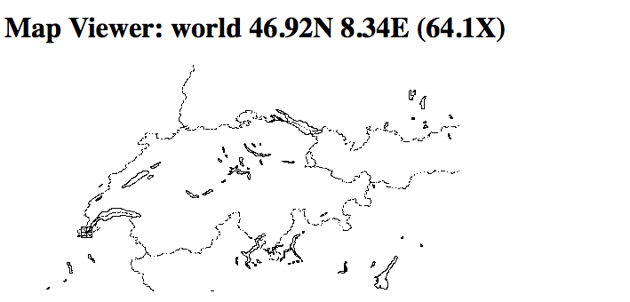A Search for the Zombie Websites of 1995

Visitors crowd the computers at the international Electronic Fair in Berlin in August 1995. Jockel Finck/Shutterstock.com
The must-visit destinations from early cyberspace are mostly gone now.
Exploring the web of the early 1990s meant wandering into strange new territory, made stranger by the way people talked about it at the time.
Terms like “cyberspace,” “World Wide Web,” and “information superhighway” sound like throwbacks now, but back then they were utterly and unironically futuristic.
This was around the same time that print newspapers found themselves publishing long lists of web addresses—presumably for people to fold up and carry with them back to their desktops, where they waited for dial-up modems to screech to life, so they could carefully key in each letter to a browser like Netscape. (Imagining the people who did this, and remembering the deliberation and curiosity it required, makes me actually joyful.)
When The New York Times published a guide to “Site-Seeing on the World Wide Web,” on January 3, 1995, it didn’t yet have its own website. (Though it did have a content partnership with America Online.) And it wouldn’t until 1996, when the Times launched “The New York Times on the Web, as the electronic publication is known.”

Today there are more than 1 billion sites on the web. But in 1995, the year AltaVista and Amazon launched, there were 23,500. (The year before that, there were only 2,738 websites, according to Internet Live Stats, a site that tracks web trends.) “For anyone with a computer, modem and so-called browser software, the place to be in 1995 is the World Wide Web, a section of the Internet overflowing with sights and sounds,” the Times wrote in its 1995 “site-seeing” guide.
The first site it recommended was “everyone’s favorite plastic oracle, on line,” a place where you could consult a Magic 8-Ball. It’s funny now: The tenor of the early web, with its gimmicks and sense of play, was eventually repeated in the early app environment. Remember when having an iPhone meant demonstrating a smattering of silly apps—things like Magic 8-Balls, virtual lighters, and digital beer that disappeared when you tilted the device?
The Magic 8-Ball website from 1995 is still live, remarkably, but it has changed. “The ‘Magic 8-Ball’ went away because of a letter from Tyco’s lawyers indicating that they didn't appreciate my abuse of their Copyright,” a message on the site now says. “Thank you Tyco, for giving me the impetus to create a far cooler web site.”
Of the 26 sites the Times recommended visiting that year, just four still work. Along with the Magic 8-Ball, there’s the website for Japan’s Science and Technology Agency, NASA’s Jet Propulsion Laboratory, and the Internet Underground Music Archive. That site only kind of exists anymore—it still has a working homepage, but it redirects to the Internet Archive when you click.

Same with Intrrr Nrrrd, which lives on only in the context of leading you to an archive of the broader Etext Archives site where it was once published. (And the earliest appearance of that website in the WayBack Machine isn’t until 1999; so it’s anyone’s guess what it looked like in 1995.)
The vanished pages are many.
Most of the URLs the Times printed in 1995 are now dead, including those that led to a guide for backpackers and wilderness trekkers; a livestream of a coffee pot; a Grateful Dead fan page; a map of estuaries; a federal spending website; a hub for online gaming; a gardening site; a site devoted to legislation affecting Massachusetts; Wired’s coverage of legal issues in cyberspace; Berkeley’s Museum of Paleontology; a graphic novel about living with cancer; an illustrated explanation of an infamous flaw in Intel's Pentium chip; a cybermall; a site for making hotel reservations in San Francisco; a site dedicated to subway routes; a virtual frog dissection; a wine-tasting club; a digital map viewer that let you zoom in to any spot on Earth; Yahoo’s internet directory from when it was still hosted by Stanford; and an informational site about zebrafish.
In some cases, you can piece together traces of what once was. There’s still a website for the Museum of Paleontology, for instance, it’s just not the same one that existed in 1995.
In other cases, there are records of sites that no longer work. That’s because some of them were legendary in their time. The coffee pot site, based on what is believed to have been the first webcam, ran for nearly eight years and remains memorialized since it went dark in 2001. The map viewer was similarly groundbreaking—it was one of the earliest mapping sites on the web, launched in 1993, though it looks primitive by today’s satellite-imagery standards. You can still catch a glimpse of it on the Internet Archive.

“Each of the thousands of World Wide Web sites opens with a ‘home page,’” the Times had written, “which serves as both a table of contents and Alice's rabbit hole into a world that may be beautiful, bizarre, or banal.”
That’s still true of the web, especially as we all fall further down the rabbit hole. The places we once visited have changed. They’re always changing.
On the website that in 1995 boasted a Magic 8-Ball for online consultation, you’ll now find “the mystical smoking head of Bob” instead. There’s still a place for visitors to submit questions.
“What was the web like in 1995?” I asked Bob this morning.
“Don’t count on it,” was the reply.
This is wise, it turns out, because the web of 1995 cannot be counted on. In fact, it’s mostly gone.





